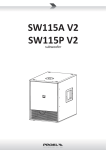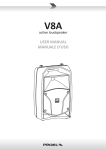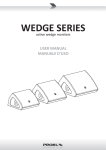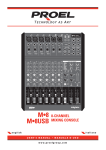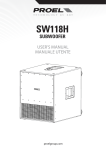Download PROEL Mi12 User manual
Transcript
Mi10 10-CH 2-BUS MIXER Mi12 12-CH 2-BUS MIXER USER MANUAL MANUALE D'USO FCC COMPLIANCE NOTICE This device complies with part 15 of the FCC rules. Opera on is subject to the following two condi ons: (1) This device may not cause harmful interference, and (2) this device must accept any interference received, including interference that may cause undesired opera on. CAUTION: Changes or modifica ons not expressly approved by the party responsible for compliance could void the user’s authority to operate the equipment. NOTE: This equipment has been tested and found to comply with the limits for a Class B digital device, pursuant to part 15 of the FCC Rules. These limits are designed to provide reasonable protec on against harmful interference in a residen al installa on. This equipment generates, uses, and can radiate radio frequency energy and, if not installed and used in accordance with the instruc on manual, may cause harmful interference to radio communica ons. However, there is no guarantee that interference will not occur in a par cular installa on. If this equipment does cause harmful interference to radio or television recep on, which can be determined by turning the equipment off and on, the user is encouraged to try to correct the interference by one or more of the following measures: • Reorient or relocate the receiving antenna. • Increase the separa on between the equipment and receiver. • Connect the equipment into an outlet on a circuit different from that to which the receiver is connected. • Consult the dealer or an experienced radio/TV technician for help. This marking shown on the product or its literature, indicates that it should not be disposed with other household wastes at the end of its working life. To prevent possible harm to the environment or human health from uncontrolled waste disposal, please separate this from other types of wastes and recycle it responsibly to promote the sustainable reuse of material resources. Household users should contact either the retailer where they purchased this product, or their local government office, for details of where and how they can take this item for environmentally safe recycling. Business users should contact their supplier and check the terms and condi ons of the purchase contract. This product should not be mixed with other commercial wastes for disposal. The lightning flash with arrowhead symbol within an equilateral triangle is intended to alert the user to the presence of uninsulated “dangerous voltage” within the product’s enclosure, that may be of sufficient magnitude to cons tute a risk of electric shock to persons. The exclama on point within an equilateral triangle is intended to alert the user to the presence of important opera ng and maintenance (servicing) instruc ons in the literature accompanying the appliance. The informa on contained in this publica on has been carefully prepared and checked. However no responsibility will be taken for any errors. All rights are reserved and this document cannot be copied, photocopied or reproduced in part or completely without wri en consent being obtained in advance from PROEL. PROEL reserves the right to make any aesthe c, func onal or design modifica on to any of its products without any prior no ce. PROEL assumes no responsibility for the use or applica on of the products or circuits described herein. Il marchio riportato sul prodo o o sulla documentazione indica che il prodo o non deve essere smal to con altri rifiu domes ci al termine del ciclo di vita. Per evitare eventuali danni all’ambiente si invita l’utente a separare questo prodo o da altri pi di rifiu e di riciclarlo in maniera responsabile per favorire il riu lizzo sostenibile delle risorse materiali. Gli uten domes ci sono invita a conta are il rivenditore presso il quale è stato acquistato il prodo o o l’ufficio locale preposto per tu e le informazioni rela ve alla raccolta differenziata e al riciclaggio per questo po di prodo o. Gli uten aziendali sono invita a conta are il proprio fornitore e verificare i termini e le condizioni del contra o di acquisto. Questo prodo o non deve essere smal to unitamente ad altri rifiu commerciali. Il simbolo del lampo con freccia in un triangolo equilatero intende avver re l'u lizzatore per la presenza di "tensioni pericolose" non isolate all'interno dell'involucro del prodo o, che possono avere una intensità sufficiente a cos tuire rischio di scossa ele rica alle persone. Il punto esclama vo in un triangolo equilatero intende avver re l'u lizzatore per la presenza di importan istruzioni per l'u lizzo e la manutenzione nella documentazione che accompagna il prodo o. Le informazioni contenute in questo documento sono state a entamente reda e e controllate. Tu avia non è assunta alcuna responsabilità per eventuali inesa ezze. Tu i diri sono riserva e questo documento non può essere copiato, fotocopiato, riprodo o per intero o in parte senza previo consenso scri o della PROEL. PROEL si riserva il diri o di apportare senza preavviso cambiamen e modifiche este che, funzionali o di design a ciascun proprio prodo o. PROEL non assume alcuna responsabilità sull’uso o sul l’applicazione dei prodo o dei circui qui descri . INDEX INDICE FCC COMPLIANCE NOTICE . . . . . . . . . . . . . . . . . . . 2 TECHNICAL SPECIFICATIONS . . . . . . . . . . . . . . . . . 4 Mi10 CONTROL PANEL (FIG.1) . . . . . . . . . . . . . . . . 5 Mi12 CONTROL PANEL (FIG.2) . . . . . . . . . . . . . . . . 6 CONNECTIONS (FIG.3) . . . . . . . . . . . . . . . . . . . . . . 7 Mi10 CONFIGURATION EXAMPLE . . . . . . . . . . . . . 8 Mi12 CONFIGURATION EXAMPLE . . . . . . . . . . . . . 9 ENGLISH LANGUAGE. . . . . . . . . . . . . . . . . . . . . . . 10 SAFETY AND PRECAUTIONS . . . . . . . . . . . . . . . . . 10 IN CASE OF FAULT . . . . . . . . . . . . . . . . . . . . . . . . . 10 CE CONFORMITY . . . . . . . . . . . . . . . . . . . . . . . . . . 10 PACKAGING, SHIPPING AND COMPLAINT . . . . . . 10 WARRANTY AND PRODUCTS RETURN . . . . . . . . . 10 INSTALLATION AND DISCLAIMER . . . . . . . . . . . . . 10 POWER SUPPLY AND MAINTENANCE . . . . . . . . . 10 GENERAL INFORMATION . . . . . . . . . . . . . . . . . . . 11 OPERATING INSTRUCTIONS (FIG. 1 / 2 / 3) . . . . . 11 SPECIFICHE TECNICHE . . . . . . . . . . . . . . . . . . . . . . 4 PANNELLO DI CONTROLLO Mi10 (FIG.1) . . . . . . . . 5 PANNELLO DI CONTROLLO Mi12 (FIG.2) . . . . . . . . 6 CONNESSIONI (FIG.3) . . . . . . . . . . . . . . . . . . . . . . . 7 Mi10 ESEMPIO CONFIGURAZIONE. . . . . . . . . . . . . 8 Mi12 ESEMPIO CONFIGURAZIONE. . . . . . . . . . . . . 9 LINGUA ITALIANA . . . . . . . . . . . . . . . . . . . . . . . . . 15 AVVERTENZE PER LA SICUREZZA . . . . . . . . . . . . . 15 IN CASO DI GUASTO . . . . . . . . . . . . . . . . . . . . . . . 15 CONFORMITÀ CE . . . . . . . . . . . . . . . . . . . . . . . . . . 15 IMBALLAGGIO, TRASPORTO E RECLAMI . . . . . . . 15 GARANZIE E RESI . . . . . . . . . . . . . . . . . . . . . . . . . 15 INSTALLAZIONE E LIMITAZIONI D’USO . . . . . . . . . 15 ALIMENTAZIONE E MANUTENZIONE . . . . . . . . . . 15 INFORMAZIONI GENERALI . . . . . . . . . . . . . . . . . . 16 ISTRUZIONI OPERATIVE (FIG. 1 / 2 / 3) . . . . . . . . 16 3 TECHNICAL SPECIFICATIONS MODEL SPECIFICHE TECNICHE Mi10 - Mi12 Connectors MODELLO Mi10 Mi12 MONO INPUT CHANNELS Mic Input Sensi vity from -10 to -50 dBu Mic Input Impedance 2 Kohm Line Input Sensi vity from +20 to -20 dBu Line Input Impedance 10 Kohm Balanced XLR-F Balanced Jack Sensibilità Ingresso Mic from -10 to -50 dBu Impedenza Ingresso Mic 2 Kohm Sensibilità Ingresso Line from +20 to -20 dBu Impedenza Ingresso Line 10 Kohm LO CUT 75Hz, 18dB/oct. LO CUT 75Hz, 18dB/oct. EQ HIGH (shelving) ±15 dB @ 12KHz EQ ALTI (shelving) ±15 dB @ 12KHz EQ MID (peaking) ±15 dB @ 2.5KHz EQ MEDI (peaking) ±15 dB @ 2.5KHz EQ LOW (shelving) ±15 dB @ 80Hz EQ BASSI (shelving) ±15 dB @ 80Hz STEREO INPUT CHANNELS Line Input Sensi vity +4 / -10 dBu Line Input Impedance 10 Kohm Balanced Jack +4 / -10 dBu Impedenza Ingresso Line 10 Kohm +4 dBu Balanced Jack C.ROOM nom. out level 0 dBu Unbalanced Jack AUX nom. out level 0 dBu Unbalanced Jack 2 - TRK nom. out level 0 dBu Unbalanced Rca 0 dBu Unbalanced Rca Livello nom. 2 - TRK IN PHONES min. impedance PHONES max. out level Presets DSP resolu on Controls 32 ohm Stereo Jack (2x) 193 mW Livello nom. MAIN MIX +4 dBu Jack Bilanciato 0 dBu Jack Sbilanciato Livello nom. AUX 0 dBu Jack Sbilanciato Livello nom. 2 - TRK OUT 0 dBu Rca Sbilanciato 0 dBu Rca Sbilanciato Impedenza min. PHONES Livello max. PHONES 256 (16 presets x 16 varia ons) 24 bit 24 bit LED display, DIAL, PEAK LED, TAP DELAY switch +22 dBu 32 ohm Jack Stereo (2x) 193 mW DIGITAL EFFECT PROCESSOR - PROFEX Presets 256 (16 preset x 16 variazioni) A/D and D/A converters 24 bit DSP resolu on Controlli GENERAL SPECIFICATIONS Max level all outputs Jack Bilanciato Livello nom. C.ROOM DIGITAL EFFECT PROCESSOR - PROFEX A/D and D/A converters Jack Bilanciato SEZIONE MASTER MAIN MIX nom. out level 2 - TRK nom. in level XLR-F Bilanciato CANALI INGRESSO STEREO Sensibilità Ingresso Line MASTER SECTION 24 bit LED display, DIAL, PEAK LED, TAP DELAY switch SPECIFICHE GENERALI Livello Massimo Uscite +22 dBu Crosstalk meas. at 1 KHz > 82 dBu Diafonia mis. a 1 KHz > 82 dBu HUM & N unweighted < -93 dBu HUM & N non pesato < -93 dBu THD+N at +4dB, 1kHz Dimensions (W x H x D) Weight < 0,01 % THD+N a +4dB, 1kHz < 0,01 % 200 x 266 x 60 mm (Mi10) 254 x 302 x 60 mm (Mi12) Dimensioni (L x A x P) 200 x 266 x 60 mm (Mi10) 254 x 302 x 60 mm (Mi12) 1.50 kg (Mi10) 2.00 kg (Mi10) Peso POWER REQUIREMENTS Supply Mains Supply Voltage, see label on the AC/AC ADAPTER, available for: 18VAC 1000mA use only supplied AC/AC ADAPTER 110-120 VAC (±10%) 50 / 60 Hz (US plug) 230-240 VAC (±10%) 50 / 60 Hz (EU plug) 240 VAC (±10%) 50 / 60 Hz (UK plug) Consump on 4 Conne ori CANALI INGRESSO MONO 32 W 1.50 kg (Mi10) 2.00 kg (Mi10) ALIMENTAZIONE Alimentazione Tensione di Rete, vedi l'e che a sull' AC/ AC ADAPTER, disponibile per: Assorbimento 18VAC 1000mA usare solo AC/AC ADAPTER incluso 110-120 VAC (±10%) 50 / 60 Hz (US plug) 230-240 VAC (±10%) 50 / 60 Hz (EU plug) 240 VAC (±10%) 50 / 60 Hz (UK plug) 32 W Mi10 CONTROL PANEL (FIG.1) PANNELLO DI CONTROLLO Mi10 (FIG.1) 13 26 14 27 36 1 33 2 3 30 32 4 39 5 38 6 21 7 37 28 9 29 10 22 34 11 23 31 12 24 17 18 20 19 15 42 41 40 5 Mi12 CONTROL PANEL (FIG.2) PANNELLO DI CONTROLLO Mi12 (FIG.2) 13 26 14 27 35 1 36 2 33 3 30 32 39 4 38 5 21 37 6 28 7 29 8 34 9 25 22 10 23 11 31 12 24 16 17 18 20 19 15 42 41 40 6 CONNECTIONS (FIG.3) CONNESSIONI (FIG.3) Ɵp - hot Ɵp - hot ring - cold cold ground sleeve - ground LINE IN, various OUT LINE IN, OUT vari LINE IN, various OUT LINE IN, OUT vari Jack (balanced) Jack (bilanciato) Jack (unbalanced) Jack (sbilanciato) Ɵp - leŌ *note: connect both cold and ground *nota: conneƩere insieme cold e ground to make cable from balanced to unbalanced per cavi da bilanciato a sbilanciato ring - right sleeve - ground PHONES PHONES Stereo Jack Jack stereo hot cold ground hot cold ground MIC INPUT MIC INPUT Balanced male XLR XLR bilanciato maschio 2TRK IN, OUT 2TRK IN, OUT Jack (unbalanced) Jack (sbilanciato) *note: connect both cold and ground to *nota: conneƩere insieme cold e ground make cable from balanced to unbalanced per cavi da bilanciato a sbilanciato 7 Mi10 CONFIGURATION EXAMPLE PERSONAL COMPUTER WITH AUDIO IN/OUT CAPABILITY Mi10 ESEMPIO CONFIGURAZIONE FLASH5A desktop monitors or other AUDIO SYSTEM HEADPHONES SAX MIC VOCAL MIC FLASH12HDA acƟve processed speaker or other AUDIO SYSTEM ACOUSTIC GUITAR with amplified pickup KEYBOARD 8 MP3 / CD / DVD PLAYER DRUM MACHINE Mi12 CONFIGURATION EXAMPLE PERSONAL COMPUTER WITH AUDIO IN/OUT CAPABILITY Mi12 ESEMPIO CONFIGURAZIONE WEDGE MONITOR or other AUDIO SYSTEM FLASH5A desktop monitors or other AUDIO SYSTEM SAX MIC HEADPHONES VOCAL MIC VOCAL MIC FLASH12HDA acƟve processed speaker or other AUDIO SYSTEM GUITAR MIC BASS DIRECT OUT KEYBOARD DRUM MACHINE MP3 / CD / DVD PLAYER 9 ENGLISH LANGUAGE SAFETY AND PRECAUTIONS • CAUTION: before using this product read carefully the following safety instruc ons. Take a look of this manual en rely and preserve it for future reference. When using any electric product, basic precau ons should always be taken, including the following: – To reduce the risk, close supervision is necessary when the product is used near children. – Protect the apparatus from atmospheric agents and keep it away from water, rain and high humidity places. – This product should be site away from heat sources such as radiators, lamps and any other device that generate heat. – Care should be taken so that objects and liquids do not go inside the product. – The product should be connected to a power supply mains line only of the type described on the opera ng instruc ons or as marked on the product. Connect the apparatus to a power supply using only power cord included making always sure it is in good condi ons. – WARNING: The mains plug is used as disconnect device, the disconnect device shall remain readily operable. – Power supply cord should be unplugged from the outlet during strong thunderstorm or when le unused for a long period of me. – Do not place objects on the product’s power cord or place it in a posi on where anyone could trip over, walk on or roll anything over it. Do not allow the product to rest on or to be installed over power cords of any type. Improper installa ons of this type create the possibility of fire hazard and/or personal injury. IN CASE OF FAULT • – – – – – • In case of fault or maintenance this product should be inspected only by qualified service personnel when: There is a flaw either in the connec ons or in the supplied connec ng cables. Liquids have spilled inside the product. The product has fallen and been damaged. The product does not appear to operate normally or exhibits a marked change in performance. The product has been lost liquids or gases or the enclosure is damaged. Do not operate on the product, it has no user-serviceable parts inside, refer servicing to an authorized maintenance centre. CE CONFORMITY • Proel products comply with direc ve 2004/108/EC (EMC), as stated in EN 55013 standard and with direc ve 2006/95/CE (LVD), as stated in EN 60065 standard. • Under the EM disturbance, the ra o of signal-noise will be changed above 10dB. PACKAGING, SHIPPING AND COMPLAINT • This unit package has been submi ed to ISTA 1A integrity tests. We suggest you control the unit condi ons immediately a er unpacking it. • If any damage is found, immediately advise the dealer. Keep all unit packaging parts to allow inspec on. • Proel is not responsible for any damage that occurs during shipment. • Products are sold “delivered ex warehouse” and shipment is at charge and risk of the buyer. • Possible damages to unit should be immediately no fied to forwarder. Each complaint for package tampered with should be done within eight days from product receipt. WARRANTY AND PRODUCTS RETURN • Proel products have opera ng warranty and comply their specifica ons, as stated by manufacturer. • Proel warrants all materials, workmanship and proper opera on of this product for a period of two years from the original date of purchase. If any defects are found in the materials or workmanship or if the product fails to func on properly during the applicable warranty period, the owner should inform about these defects the dealer or the distributor, providing receipt or invoice of date of purchase and defect detailed descrip on. This warranty does not extend to damage resul ng from improper installa on, misuse, neglect or abuse. Proel S.p.A. will verify damage on returned units, and when the unit has been properly used and warranty is s ll valid, then the unit will be replaced or repaired. Proel S.p.A. is not responsible for any "direct damage" or "indirect damage" caused by product defec veness. INSTALLATION AND DISCLAIMER • Proel products have been expressly designed for audio applica on, with signals in audio range (20Hz to 20kHz). Proel has no liability for damages caused in case of lack of maintenance, modifica ons, improper use or improper installa on non-applying safety instruc ons. • Proel S.p.A. reserves the right to change these specifica ons at any me without no ce. • Proel S.p.A. declines any liability for damages to objects or persons caused by lacks of maintenance, improper use, installa on not performed with safety precau ons and at the state of the art. POWER SUPPLY AND MAINTENANCE • Clean only with dry cloth. • Before connec ng the product to the mains outlet make certain that the mains line voltage matches that shown on the rear of the product, a tolerance of up to ±10% is acceptable. 10 GENERAL INFORMATION Thank you for having chosen a PROEL product. The new Mi Series has been created by PROEL in order to offer very compact mixers with a high input density at a very affordable price. The series includes 3 models with 6, 10 and 12 channels, featuring in a very compact package a high number of inputs and a full set of intelligent features, able to sa sfy most of the sound reinforcement applica ons. Mi10 and Mi12 feature one of the finest digital effects of its class, the PROEL 24bit PROFEX DSP, including 256 state-ofart presets and a convenient LED display. Both model deliver a clean and accurate sound and full mixing capability in a stylish and unconven onal case. OPERATING INSTRUCTIONS (FIG. 1 / 2 / 3) 1. MIC Input This is a female XLR connector, which accepts a balanced microphone input from almost any type of microphone. The XLR inputs are wire as follows: Pin 1 = shield or ground Pin 2 = + posi ve or "hot" Pin 3 = - nega ve or "cold" 2. LINE Input This is a ¼” (6.3mm) jack connector, which accepts a balanced or unbalanced line level input signal from almost any source. When connec ng a balanced signal, wire them as follows: Tip = + posi ve or "hot" Ring = - nega ve or "cold" Sleeve = shield or ground When connec ng an unbalanced signal, wire them as follows: Tip = + posi ve or "hot" Sleeve = shield or ground 3. GAIN Control The gain control adjusts the input sensi vity of the mic and line inputs. This allows the signal from mics and instruments to be adjusted to op mal internal levels. If the signals are plugged into the XLR input there is a 10 dB of gain with the knob turned all way down, ramping up to 50 dB of gain fully up. When connected to the jack input, there is 20 dB of a enua on all way down and 20 dB of gain fully up, with a unity gain (0 dB) if centered. 4. LO CUT switch This switch cuts low frequencies below 75 Hz at a rate of 18 dB per octave. The LO CUT filter can help reducing the possibility of feedback in live situa ons and to reducing stage rumble, mic handling clunks, and breath pops. 5. EQ sec on HIGH control This control gives you up to 15dB boost or cut at 12KHz with a "SHELVING" curve shape. Use it to increase or reduce the sound "clarity" or "brightness". 6. EQ sec on MID control This control gives you up to 15 dB boost or cut at 2.5 KHz with a "PEAKING" curve shape. Use it to add or reduce the sound "presence". 7. EQ sec on LOW control This control gives you up to 15dB boost or cut at 80Hz with a "SHELVING" curve shape. Use it to increase or reduce the sound "punch". 8. AUX 1 control (pre) This control sends the signal to the AUX 1 output. This signal is pre-fader, meaning that it doesn't depend on the posi on of the channel's FADER. NOTE: this control is present on Mi12 only. 9. AUX 2 (Mi12) / AUX 1 (Mi10) control (send to FX post) This control sends the signal to the AUX 2 (Mi12) / AUX 1 (Mi10) output and to the internal PROFEX digital effect processor. This signal is post-fader, or in other words it depends on the posi on of the channel's FADER. 10. PAN control It adjusts the amount of channel signal sent to the le versus the right outputs. Use it to posi on the signal in a panoramic stereo scene. 11. PEAK detector The PEAK LED flashes when the input signal is near to the CLIPPING point. IMPORTANT: if the LED PEAK flashes reduce the level of the input signal using the GAIN control. 11 12. FADER LEVEL control It adjusts the level of the channel signal and send it to the MAIN MIX outputs. 13. LINE LEFT/MONO Input This is a female JACK connector, which accepts a balanced or unbalanced line level input signal from almost any source. If the RIGHT jack is not inserted, this channel operate like a MONO channel with this input as a single signal source. Wiring is the same of point 2. 14. LINE RIGHT Input This is a JACK connector, which accepts a balanced or unbalanced line level input signal from almost any source. This is used only in presence of LEFT jack input to use the channel as STEREO. 15. +4/-10 GAIN Switch The gain switch adjusts the input sensi vity of the line inputs. This allows the signal from instruments to be adjusted to op mal internal levels. If the switch is up (+4 dBu) the input stage is set to accept high level line signals, if the switch is down the input stage is set to accept low level line signals. 16. AUX 1 level control pre-fader This control sends the signal to the AUX 1 output. This signal is pre-fader, meaning that it doesn't depend on the posi on of the channel's FADER. NOTE: this control is present on Mi12 only. 17. AUX 2 (Mi12) / AUX 1 (Mi10) level control post-fader send to FX This control sends the signal to the AUX 2 (Mi12) / AUX 1 (Mi10) output and to the internal PROFEX digital effect processor. This signal is post-fader, or in other words it depends on the posi on of the channel's FADER. 18. BAL control It adjusts the amount of channel signal sent to the le versus the right outputs if the channel is used as MONO, or it fades the LEFT or RIGHT signal amount if the channel is used as STEREO. 19. PEAK detector The PEAK LED flashes when the input signal is near to the CLIPPING point. IMPORTANT: if the LED PEAK flashes reduce the level li ing up the GAIN switch. 20. FADER LEVEL control It adjusts the level of the channel signal and send it to the MAIN MIX outputs. 21. PRESETS selector and display The internal PROFEX digital effect processor is built around a powerful DSP and 24bit AD/DA converters. It includes 16 different presets of studio-grade effect algorithm, each one featuring 16 different varia ons of the internal parameters, for a total of 256 effects available. HOW TO USE THE PROFEX EFFECT: - rotate the SELECTOR knob to choose the type of effect (preset) you want to use; - to select a varia on of the preset, press and hold the knob un l the display flashes; - rotate the knob and choose one of the 16 varia ons available; - press and hold again the knob un l the display stops flashing to confirm the selec on and to return back to the preset selec on; - send the signal to the effect with the AUX control (9)(17) of the channel you want to add the effect to; - rotate the FX LEVEL (24) knob un l you hear the effect added to the original signal; - adjust the AUX controls (9)(17) just before the signal input clipping indicated by the peak led (23); - re-adjust the FX LEVEL (24) knob to combine the wet effected signal with the natural dry signal. NOTE: the preset and the varia on selected in the PROFEX effect are kept in the memory even if you turn off the mixer. PRESET DESCRIPTION: p 1. BRIGHT HALL - This type of reverb simulates the ambience of a grand concert hall. Dense, smooth reverb with long pre delay and a lot of high frequency reflec ons. Works well with vocals, electric and acous c guitars, strings. The VARIATIONS vary the decay me and the hall size from bigger [1] to smallest [16]. p 2. DARK HALL - This type of reverb simulates the ambience of a grand concert hall. Dense, smooth reverb with long pre delay and a few of high frequency reflec ons. Works well with vocals, guitars, woodwinds. The VARIATIONS vary the decay me and the hall size from bigger [1] to smallest [16]. p 3. BRIGHT ROOM - This type of reverb reproduces the more in mate ambience of natural room acous cs. Feature a lot of early reflec ons with a lot of high frequency. Works well with vocals, woodwinds, strings, drums. The VARIATIONS vary the decay me and the room size from bigger [1] to smallest [16]. p 4. DARK ROOM - This type of reverb reproduces the more in mate ambience of natural room acous cs. Feature a lot lot of early reflec ons with a few of high frequency. Works well with vocals, fingered guitars, drums. 12 The VARIATIONS vary the decay me and the room size from bigger [1] to smallest [16]. p 5. VOCAL 1 (STAGE REVERB) - Amazing reverb designed for vocals with a long tail. The VARIATIONS vary the decay me from long tail [1] to short tail [16], alterna ng plate, spring or hall types of reverb. p 6. VOCAL 2 (CLUB REVERB) - Amazing reverb designed for vocals with a dense tail. The VARIATIONS vary the decay me from long tail [1] to short tail [16], alterna ng tape, hall or spring types of reverb. p 7. PLATE - This is a simula on of metal plate reverb, as used on classic recordings from the '70s and '80s. The VARIATIONS vary the decay me from long tail [1] to short tail [16]. p 8. STEREO DELAY - Echo effect with ping-pong of le and right channels. The VARIATIONS vary from long delay mes [1] to short delay mes [16]. p 9. STEREO TAP DELAY - Like STEREO DELAY above with me set by the user TAP bu on (22) just below. The VARIATIONS vary from 5% [1] to 90% [16] of feedback quan ty. p 10. MONO TAP DELAY - Typical mono delay with me set by the user TAP bu on (22) just below. The VARIATIONS vary from 0% [1] to 75% [16] of feedback quan ty. p 11. CHORUS - Typical modula on effect, provides a so , ethereal sweeping effect. Perfect for enhancement of electric and acous c guitar and bass. Also adds a drama c effect to vocals, par cularly group harmonies and choirs. The VARIATIONS increase the modula on frequency from 0.5Hz [1] to 5Hz [16]. p 12. FLANGER - Typical modula on effect, creates a strong sweeping effect, par cularly effec ve on rock electric guitar, lead and rhythm. The VARIATIONS increases the modula on frequency from 0.2Hz [1] to 3Hz [16]. p 13. REVERB+DELAY 1 - Typical vocal hall reverb and stereo delay combined toghether. The VARIATIONS vary from long tail [1] to short tail [16]. p 14. REVERB+DELAY 2 - Typical vocal hall reverb and mono delay combined toghether. The VARIATIONS vary from long tail [1] to short tail [16]. p 15. REVERB+TAP DELAY - Typical vocal hall reverb and mono TAP delay combined toghether. The mono delay me is set by the user TAP bu on (22) just below. The VARIATIONS vary from long tail [1] to short tail [16] and from 0% to 75% of feedback quan ty [1-16]. p 16. REV+CHORUS - Typical vocal reverb and chorus effect combined toghether. The VARIATIONS vary from long tail [1] to short tail [16] and increases the modula on frequency from 0.5Hz to 5Hz [1-16]. 22. TAP bu on When “TAP DELAY” effects (p 9, 10, 15) are selected, by pushing at least two mes this bu on, it’s possible to set the desired delay me, according to music rhythm. The TAP LED flashes in sync with the delay me set. 23. PEAK detector The PEAK LED flashes when the effect input signal is near to the A/D satura on point of the PROFEX processor. IMPORTANT: if the LED PEAK flashes reduce the effect input level turning down the AUX2 (Mi12) / AUX1 (Mi10) controls. 24. FX LEVEL control It adjusts the level of the internal effect signal sent to the MAIN MIX outputs. 25. FX TO AUX1 (Mi12 only) It adjusts the level of the internal effect signal sent to the AUX 1 output. 26. 2TRK Inputs Use these unbalanced RCA connectors to patch the output of a player, such as an analog tape deck, MP3 player, CD/DVD player or a Personal Computer. 27. 2TRK Output Use these unbalanced RCA connectors to send out the MAIN MIX signal to a recorder, such as an analog tape or an A/D converter connected to a Personal Computer. 28. 2TRK IN LEVEL control It adjust the level of the 2TRK INPUT. 29. TO MIX / TO PHONES switch Use this switch to route the signal coming from 2TRK input to MAIN MIX or to C.ROOM/PHONES only. 30. MAIN MIX L & R jack output (balanced) These JACK connectors (+4dBu) provide a balanced line level signal from the MAIN MIX stereo bus. NOTE: the MAIN OUT is a true balanced output that can send the signal on a balanced line with or without a phantom power ac ve. So the Mi mixer can also be used as a combina on mixer + DI box for sending the signals to a bigger main mixer console. 13 31. MAIN MIX FADER control The MAIN MIX FADER controls the output level just before the MAIN MIX outputs and the 2TRK outputs. When the fader is fully down the MAIN MIX is off , the "0" marking indicates a +4dBu nominal output level. Typically this fader is set near the "0" label and le alone, but it can be used for song fadeouts or quick system-wide mutes. 32. C.ROOM L & R jack outputs These JACK connectors provide an unbalanced line-level signal that can be used to monitor the MAIN MIX program or as an addi onal output. 33. PHONES stereo jack output STEREO JACK connector for the headphones output: only stereo headphones with a minimum impedance of 32 Ohms should be connected to this output. 34. C.ROOM/PHONES LEVEL control This controls the CONTROL ROOM and PHONES output's level. NOTE: The signal at these outputs is the same. 35. AUX 1 jack output (Mi12 only) This jack connector sends out unbalanced line-level signals made of the sum of the input channels' AUX 1 sends, usually for connec ng to the inputs of an external effect devices or stage monitor amplifiers. This signal is pre-fader, meaning that it doesn't depend on the posi on of the channel's FADER. 36. AUX 1 (Mi10) / AUX2 (Mi12) jack output This jack connector sends out unbalanced line-level signals made of the sum of the input channels' AUX 1 (Mi10) or AUX 2 (Mi12) sends, usually for connec ng to the inputs of an external effect devices or stage monitor amplifiers. This signal is post-fader, or in other words it depends on the posi on of the channel's FADER. 37. L & R LEVEL METERS The level meters are made of two columns of of four LEDs with three colours to indicate different ranges of signal level: • green = shows the normal opera ve level of the signal (from -20 to 0 dBpeak) • yellow = shows the nominal opera ve level of the signal (from 0 to +6 dBpeak) • red = shows a high signal level (near +20 dBpeak CLIP level). 38. +48V phantom switch This switch ac vates (LED on) and deac vates (LED Off) the phantom power on MIC Inputs. Most professional condenser microphones require phantom power, which is a lower DC voltage delivered to the microphone on pin 2 and 3 of the XLR microphone connector. Dynamic microphones do not require phantom power, however phantom power will not harm most dynamic microphones should you plug one in while the phantom power is on. Check the manual of your microphone to find out for sure whether or not phantom power can damage it. 39. ON led Indicates when the mixer is switched on. 40. 18V~ socket Here’s where you plug in your mixer’s external power supply. You should always connect your power supply to the mixer before you plug the power supply into an electrical outlet. 41. POWER switch Switch this one on and your mixer has power. Switch it off and it doesn’t. Make sure that all master output knobs are turned all the way down when powering your mixer up or down. 42. PRODUCT LABEL In this label are wri en the most important informa on about the mixer, model, line voltage, consump on, serial number. 14 LINGUA ITALIANA AVVERTENZE PER LA SICUREZZA • ATTENZIONE: Durante le fasi di uso o manutenzione, devono essere prese alcune precauzioni onde evitare danneggiamen alle stru ure meccaniche ed ele roniche del prodo o. Prima di u lizzare il prodo o, si prega di leggere a entamente le seguen istruzioni per la sicurezza. Prendere visione del manuale d’uso e conservarlo per successive consultazioni: – In presenza di bambini, controllare che il prodo o non rappresen un pericolo. – Posizionare l’apparecchio al riparo dagli agen atmosferici e a distanza di sicurezza dall’acqua, dalla pioggia e dai luoghi ad alto grado di umidità. – Collocare o posizionare il prodo o lontano da fon di calore quali radiatori, griglie di riscaldamento e ogni altro disposi vo che produca calore. – Evitare che qualsiasi ogge o o sostanza liquida entri all’interno del prodo o. – Il prodo o deve essere connesso esclusivamente alla rete ele rica delle cara eris che descri e nel manuale d’uso o scri e sul prodo o, usando esclusivamente il cavo rete in dotazione e controllando sempre che sia in buono stato, in par colare la spina e il punto in cui il cavo esce dal prodo o. – ATTENZIONE: Se il cavo rete viene scollegato dall'apparecchio per spegnerlo, il cavo rete rimarrà opera vo in quanto la sua spina è ancora collegata alla rete ele rica. – Disconne ere il prodo o dalla rete ele rica durante for temporali o se non viene usato per un lungo periodo di tempo. – Non disporre ogge sul cavo di alimentazione, non disporre i cavi di alimentazione e segnale in modo che qualcuno possa incianparci. Altresì non disporre l’apparecchio sui cavi di altri appara . Installazioni inappropriate di questo po possono creare la possibilità di rischio di incendio e/o danni alle persone. IN CASO DI GUASTO • – – – – – • In caso di guasto o manutenzione questo prodo o deve essere ispezionato da personale qualificato quando: Ci sono dife sulle connessioni o sui cavi di collegamento in dotazione. Sostanze liquide sono penetrate all’interno del prodo o. Il prodo o è caduto e si è danneggiato. Il prodo o non funziona normalmente esibendo una marcato cambio di prestazioni. Il prodo o perde sostanze liquide o gassose o ha l’involucro danneggiato. Non intervenire sul prodo o. Rivolgersi a un centro di assistenza autorizzato Proel. CONFORMITÀ CE • I Prodo Proel sono conformi alla dire va 2004/108/EC (EMC), secondo lo standard EN 55013 ed alla dire va 2006/95/CE (LVD), secondo lo standard EN 60065. • Se so oposto a disturbi EM, il rapporto segnale-rumore può essere superiore a 10dB. IMBALLAGGIO, TRASPORTO E RECLAMI • L’imballo è stato so oposto a test di integrità secondo la procedura ISTA 1A. Si raccomanda di controllare il prodo o subito dopo l’apertura dell’imballo. • Se vengono riscontra danni informare immediatamente il rivenditore. Conservare quindi l’imballo completo per perme erne l’ispezione. • Proel declina ogni responsabilità per danni causa dal trasporto. • Le merci sono vendute “franco nostra sede” e viaggiano sempre a rischio e pericolo del distributore. • Eventuali avarie e danni dovranno essere contesta al ve ore. Ogni reclamo per imballi manomessi dovrà essere inoltrato entro 8 giorni dal ricevimento. GARANZIE E RESI • I Prodo Proel sono provvis della garanzia di funzionamento e di conformità alle proprie specifiche, come dichiarate dal costru ore. • La garanzia di funzionamento è di 24 mesi dopo la data di acquisto. I dife rileva entro il periodo di garanzia sui prodo vendu , a ribuibili a materiali dife osi o dife di costruzione, devono essere tempes vamente segnala al proprio rivenditore o distributore, allegando evidenza scri a della data di acquisto e descrizione del po di dife o riscontrato. Sono esclusi dalla garanzia dife causa da uso improprio o manomissione. Proel SpA constata tramite verifica sui resi la dife osità dichiarata, correlata all’appropriato u lizzo, e l’effe va validità della garanzia; provvede quindi alla sos tuzione o riparazione dei prodo , declinando tu avia ogni obbligo di risarcimento per danni dire o indire eventualmente derivan dalla dife osità. INSTALLAZIONE E LIMITAZIONI D’USO • I Prodo Proel sono des na esclusivamente ad un u lizzo specifico di po sonoro: segnali di ingresso di po audio (20Hz-20kHz). Proel declina ogni responsabilità per danni a terzi causa da mancata manutenzione, manomissioni, uso improprio o installazione non eseguita secondo le norme di sicurezza. • La Proel S.p.a. si riserva di modificare il prodo o e le sue specifiche senza preavviso. • Proel declina ogni responsabilità per danni a terzi causa da mancata manutenzione, manomissioni, uso improprio o installazione non eseguita secondo le norme di sicurezza e a regola d'arte. ALIMENTAZIONE E MANUTENZIONE • Pulire il prodo o unicamente con un panno asciu o. • Prima di collegare l'apparecchio alla presa di corrente, accertatevi che la tensione di rete corrisponda a quella indicata sul retro dell’apparato, è consen to un margine del ±10% rispe o al valore nominale. 15 INFORMAZIONI GENERALI Grazie per aver scelto un prodo o PROEL. La nuova serie Mi è stata creata da PROEL per fornire mixer molto compa con un gran numero di ingressi ad un prezzo conveniente. La serie include 3 modelli con 6, 10 e 12 canali i quali offrono, in dimensioni estremamente compa e, un elevato numero di ingressi ed un set completo di funzioni intelligen e sono in grado di soddisfare le più svariare applicazioni di sound reinforcement. Mi10 e Mi12 offrono uno dei dei migliori effe digitali della categoria, il DSP a 24bit PROFEX di PROEL, che include 256 preset allo stato dell'arte e un pra co display a LED. Entrambi i modelli offrono possibilità di missaggio avanzate con la qualità delle consolle professionali e con un design di s le non convenzionale. ISTRUZIONI OPERATIVE (FIG. 1 / 2 / 3) 1. MIC (ingresso microfono) È un conne ore femmina XLR, in grado di acce are un segnale microfonico bilanciato da ogni po di microfono. L'ingresso XLR ha i seguen terminali: Pin 1 = schermo o massa Pin 2 = + posi vo o "caldo" Pin 3 = - nega vo o "freddo" 2. LINE (ingresso linea) È un conne ore femmina da ¼” (6.3mm) po jack, in grado di acce are un segnale a livello linea bilanciato o sbilanciato da ogni po di sorgente. Quando si collega un segnale bilanciato, le terminazioni sono le seguen : Tip (punta) = + posi vo o "caldo" Ring (anello) = - nega vo o "freddo" Sleeve (manico o) = schermo o massa Quando si collega un segnale sbilanciato, le terminazioni sono le seguen : Tip (punta) = + posi vo o "caldo" Sleeve (manico o) = schermo o massa 3. GAIN (controllo guadagno) Il controllo GAIN regola la sensibilità di ingresso dell'ingresso MIC o LINE. Questo perme e di regolare il segnale in ingresso da microfoni o strumen al livello o male interno del mixer. Se il segnale è collegato all'ingresso XLR si hanno 10 dB di guadagno con la manopola girata al minimo e fino a 50 dB girandola verso il massimo. Quando collegato all'ingresso jack si hanno 20 dB di a enuazione con la manopola girata al minimo e 20 dB di guadagno se girata al massimo, con un guadagno unitario (0 dB) se posta al centro. 4. LO CUT (filtro elimina bassi) Questo tasto elimina le basse frequenze al di so o dei 75 Hz con 18 dB per o ava. L'uso del filtro LO CUT è consigliato dal vivo perché riduce la possibilità di rientri (feedback) e i rumori da maneggiamento dei microfoni, da vibrazioni del palco e del respiro. 5. EQ HI (equalizzatore controllo al ) Questo controllo perme e di guadagnare o a enuare fino a 15dB a 12KHz con una curva di po "SHELVING". Da usarsi per aumentare o ridurre la "chiarezza" o "brillanza" del suono. 6. EQ MID (equalizzatore controllo medi) Questo controllo perme e di guadagnare o a enuare fino a 15 dB a 2.5 KHz con una curva po "PEAKING". Da usarsi per aumentare o ridurre la "presenza" del suono. 7. EQ LOW (equalizzatore controllo bassi) Questo controllo perme e di guadagnare o a enuare fino a 15dB a 80Hz con una curva di po "SHELVING". Da usarsi per aumentare o ridurre il "vigore" del suono. 8. AUX 1 (controllo livello pre-fader) Questo controllo invia il segnale all'uscita AUX 1. Questo segnale è pre-fader, che significa che non dipende dalla posizione del controllo di livello del canale. NOTA: questo controllo è presente solo su Mi12. 9. AUX 2 (Mi12) / AUX 1 (Mi10) (controllo livello post-fader mandata FX) Questo controllo invia il segnale all'uscita AUX 2 (Mi12) / AUX 1 (Mi10) ed all'effe o interno (PROFEX digital effect processor). Questo segnale è post-fader, o in altre parole esso dipende dalla posizione del controllo di livello del canale. 10. PAN (controllo panoramico) Regola la quan tà del segnale da inviare alle uscite sinistra o destra. Da usarsi per posizionare il suono in una scena panoramica stereo. 16 11. PEAK (rilevatore di picco) Il led PEAK lampeggia quando il segnale di ingresso e prossimo alla distorsione. IMPORTANTE: se il led PEAK lampeggia ridurre il livello del segnale di ingresso usando il controllo del guadagno (GAIN). 12. FADER LEVEL (controllo di livello del canale) Regola il livello del segnale del canale e lo invia alle uscite MAIN MIX. 13. LINE LEFT/MONO (ingresso linea sinistro/mono) È un conne ore JACK in grado di acce are un segnale di livello linea bilanciato o sbilanciato da ogni po di sorgente. Se il jack LINE RIGHT non è inserito, questo canale opera come un canale MONO con questo ingresso come sorgente unica. I terminali sono gli stessi del punto 2. 14. LINE RIGHT (ingresso linea destro) È un conne ore po jack in grado di acce are un segnale a livello linea bilanciato o sbilanciato da ogni po di sorgente. È usato solo in presenza del jack LINE LEFT per usare il canale in modalità STEREO. 15. +4/-10 GAIN (sele ore guadagno) Il tasto gain regola la sensibilità dell'ingresso di linea. Questo perme e ai segnali degli strumen di essere regola al livello interno o male. Se il tasto è alzato (+4 dBu) l'ingresso è impostato per acce are livelli di linea eleva , se il tasto è abbassato (-10dBu) l'ingresso è impostato per acce are livelli di linea bassi. 16. AUX 1 (controllo livello pre-fader) Questo controllo invia il segnale all'uscita AUX 1. Questo segnale è pre-fader, che significa che non dipende dalla posizione del controllo di livello del canale. NOTA: questo controllo è presente solo su Mi12. 17. AUX 2 (Mi12) / AUX 1 (Mi10) (controllo livello post-fader mandata FX) Questo controllo invia il segnale all'uscita AUX 2 (Mi12) / AUX 1 (Mi10) ed all'effe o interno (PROFEX digital effect processor). Questo segnale è post-fader, o in altre parole esso dipende dalla posizione del controllo di livello del canale. 18. BAL (controllo bilanciamento) Regola la quan tà del segnale da inviare alle uscite sinistra o destra se il canale è usato in MONO, oppure riduce la quan tà di segnale destro e sinistro se il canale è usato in STEREO. 19. PEAK (rilevatore di picco) Il led PEAK lampeggia quando il segnale di ingresso e prossimo alla distorsione. IMPORTANTE: se il led PEAK lampeggia ridurre il livello del segnale di ingresso commutando su alto il tasto GAIN. 20. FADER LEVEL (controllo di livello del canale) Regola il livello del segnale del canale e lo invia alle uscite MAIN MIX. 21. PRESETS (sele ore e display effe o) L'effe o interno (PROFEX digital effect processor) è basato su un potente DSP e su conver tori AD/DA a 24bit. Include 16 preset con algoritmi di effe o studio-grade, ognuno dei quali dispone di 16 varian dei parametri, per un totale di 256 effe disponibili. COME USARE l'EFFETTO PROFEX: - ruotare il sele ore per scegliere il po di effe o (preset) che si vuole usare; - per selezionare una variazione del preset, premere per almeno due secondi la manopola fino a quando il display lampeggia; - quindi ruotare la manopola per scegliere una delle 16 variazioni; - premere di nuovo per almeno due secondi la manopola finché il display sme e di lampeggiare per confermare la variazione e tornare alla selezione dei preset; - inviare il segnale all'effe o usando il controllo AUX (9)(17) del canale a cui si vuole aggiungere l'effe o; - ruotare la manopola FX LEVEL (24) fino ad udire l'effe o, - regolare i controlli AUX (9)(17) prima della saturazione del segnale indicata dal LED di picco (23), - regolare nuovamente la manopola FX LEVEL per combinare il segnale dell'effe o con il segnale naturale. NOTA: il PROFEX man ene in memoria il preset e la variazione seleziona anche se il mixer viene spento. DESCRIZIONE DEI PRESET: p 1. BRIGHT HALL - Questo po di riverbero simula l'ambiente di una grande sala da concerto. Denso e armonioso riverbero con una coda lunga e molte riflessioni di alte frequenze. Ada o a voci, chitarre ele riche e acus che, archi. Le variazioni cambiano il tempo di decadimento e la grandezza della sala da grande [1] a piccola [16]. p 2. DARK HALL - Questo po di riverbero simula l'ambiente di una grande sala da concerto. Denso e armonioso riverbero con una coda lunga e poche riflessioni di alte frequenze. Ada o a voci, chitarre, fia . Le variazioni cambiano il tempo di decadimento e la grandezza della sala da grande [1] a piccola [16]. 17 p 3. BRIGHT ROOM - Questo po di riverbero riproduce un più in mo ambiente acus co di una stanza. Cara erizzato da veloci e sparpagliate prime riflessioni con molte alte frequenze. Ada o a voci, fia , archi, percussioni. Le variazioni cambiano il tempo di decadimento e la grandezza della stanza da grande [1] a piccola [16]. p 4. DARK ROOM - Questo po di riverbero riproduce un più in mo ambiente acus co di una stanza. Cara erizzato da veloci e sparpagliate prime riflessioni con poche alte frequenze. Ada o a voci, chitarre pizzicate, percussioni. Le variazioni cambiano il tempo di decadimento e la grandezza della stanza da grande [1] a piccola [16]. p 5. VOCAL 1 (STAGE REVERB) - Riverbero modellato per voci con coda lunga. Le variazioni cambiano il tempo di decadimento da lungo [1] a corto [16] alternando le varie pologie di riverberi plate, spring o hall. p 6. VOCAL 2 (CLUB REVERB) - Riverbero modellato per voci con coda densa. Le variazioni cambiano il tempo di decadimento da lungo [1] a corto [16] alternando le varie pologie di riverberi tape, hall o spring. p 7. PLATE - Questa è una simulazione del classico riverbero "plate", usato nelle registrazioni degli anni '70 e '80. Le variazioni cambiano il tempo di decadimento da lungo [1] a corto [16]. p 8. STEREO DELAY - Effe o eco con ping-pong sui canali sinistro e destro. Le variazioni vanno da un tempo di ripe zione lungo [1] a uno corto [16]. p 9. STEREO TAP DELAY - Come lo STEREO DELAY qui sopra con il tempo impostabile con il tasto TAP (22) posto so o. Le variazioni cambiano la quan tà delle ripe zioni (feedback) dal 5% [1] al 90% [16]. p 10. MONO TAP DELAY - Tipico eco mono con tempo impostabile con il tasto TAP (22) posto so o. Le variazioni cambiano la quan tà delle ripe zioni (feedback) dal 0% [1] al 75% [16]. p 11. CHORUS - Tipico effe o modulato provvisto di una soffice ed eterea ondulazione di frequenza. Perfe o per esaltare chitarre e bassi ele rici ed acus ci. Esaltante anche su voci, in par colare gruppi o cori. La variazione aumenta la frequenza di modulazione da 0.5 Hz [1] a 5 Hz [16]. p 12. FLANGER - Tipico effe o modulato cara erizzato da una decisa spazzolata in frequenza. Usato in par colare su chitarre ele riche ed acus che, sia soliste che ritmiche. La variazione aumenta la frequenza di modulazione da 0.2 Hz [1] a 3 Hz [16]. p 13. REVERB+DELAY 1 - Tipico riverbero per voce e stereo delay combina assieme. Le variazioni cambiano il tempo di decadimento da lungo [1] a corto [16]. p 14. REVERB+DELAY 2 - Tipico riverbero per voce e mono delay combina assieme. Le variazioni cambiano il tempo di decadimento da lungo [1] a corto [16]. p 15. REVERB+TAP DELAY - Tipico riverbero per voce po hall e mono TAP delay combina assieme. Il tempo del mono delay è impostabile con il tasto TAP (22) posto so o Le variazioni cambiano il tempo di decadimento da lungo [1] a corto [16] e la quan tà delle ripe zioni (feedback) dal 0% al 75% [1-16]. p 16. REV+CHORUS - Tipico riverbero per voce e effe o chorus combina assieme. Le variazioni cambiano il tempo di decadimento da lungo [1] a corto [16] ed aumentano la frequenza di modulazione da 0.5Hz a 5Hz [1-16]. 22. TAP (pulsante per impostare il tempo) Quando l'effe o “TAP DELAY” è selezionato (p 9, 10, 15), premendo almeno due volte questo pulsante è possibile impostare il tempo di ripe zione desiderato, secondo il ritmo musicale. 23. PEAK (rilevatore di picco) Questo LED di picco lampeggia quando il segnale di ingresso dell'effe o è prossimo a saturare il conver tore A/D del processore PROFEX. IMPORTANTE: se il LED PEAK lampeggia ridurre il livello di ingresso abbassando i controlli AUX2 (Mi12) / AUX1 (Mi10). 24. FX LEVEL (livello effe o) Regola il livello del segnale dell'effe o interno inviato alle uscite MAIN MIX. 25. FX TO AUX1 (livello effe o su AUX 1 solo per Mi12) Regola il livello del segnale dell'effe o interno verso l'uscita AUX1. 26. 2TRK INPUT (ingressi rca stereo) Usare ques ingressi sbilancia con conne ori RCA per collegare l'uscita di una sorgente linea quale un registratore analogico, un le ore MP3, un le ore CD/DVD, l'uscita audio di un computer. 27. 2TRK OUTPUT (uscite rca stereo) Usare ques conne ori RCA sbilancia per inviare il segnale di uscita del MAIN MIX a un registratore, quale un registratore a casse e analogico od un computer con ingresso audio. 18 28. 2TRK IN LEVEL (controllo di livello) Regola il livello dell'ingresso 2TRK INPUT. 29. TO MIX / TO PHONES (tasto) Usare questo tasto per indirizzare il segnale proveniente dall'ingresso 2TRK IN al MAIN MIX o alle uscite C.ROOM/ PHONES solamente. 30. MAIN MIX L & R (uscite jack bilanciate) Ques conne ori JACK (+4dBu) forniscono un'uscita di livello linea bilanciata del bus stereo MAIN MIX. NOTA: la MAIN OUT è una uscita realmente bilanciata che può inviare il segnale su una linea bilanciata con o senza la phantom power a va. Pertanto Mi10 e Mi12 possono essere u lizza come una combinazione mixer + DI box per inviare il segnale a un mixer principale. 31. MAIN MIX FADER (livello uscita MIX) Il MAIN MIX FADER controlla il livello di uscita esa amente prima le uscite MAIN MIX e delle uscite 2TRK OUT. Quando il fader è al minimo il MAIN MIX è spento, il punto "0" indica un livello nominale di uscita su cavo bilanciato di +4dBu. Tipicamente questo fader viene impostato prossimo allo "0" e ivi lasciato, ma può essere usato anche per sfumare le canzoni o silenziare velocemente l'impianto audio in caso di necessità. 32. C.ROOM L & R (uscite jack) Ques conne ori JACK forniscono un uscita sbilanciata a livello linea che può essere usata per controllare separatamente ed anche come uscita supplementare, il programma in uscita dal MAIN MIX. 33. PHONES (uscita jack stereo per cuffia) Conne ore STEREO JACK per uscita cuffia: le cuffie devono avere una impedenza minima di 32 Ohms. 34. C.ROOM/PHONES LEVEL (livello uscita cuffia e c.room) Regola il livello delle uscite jack CONTROL ROOM e PHONES. NOTA: Il segnale di queste due uscite è lo stesso. 35. AUX 1 OUT (uscita jack solo su Mi12) Questo conne ore jack invia all'esterno un segnale linea sbilanciato composto dalla somma di tu e le mandate AUX 1 dei singoli canali. È solitamente usato per conne ere l'ingresso di un effe o esterno o di monitor da palco amplifica . Questo segnale è pre-fader, che significa che non dipende dalla posizione del controllo di livello del canale. 36. AUX 1 (Mi10) / AUX2 (Mi12) OUT (uscita jack) Questo conne ore jack invia all'esterno un segnale linea sbilanciato composto dalla somma di tu e le mandate AUX 1 (Mi10) / AUX 2 (Mi12) dei singoli canali. È solitamente usato per conne ere l'ingresso di un effe o esterno o di monitor da palco amplifica . Questo segnale (post-fader) dipende dalla posizione del controllo di livello del canale. 37. L & R LEVEL METERS (indicatori di livello) Gli indicatori di livello sono cos tui di due colonne di qua ro led di tre colori, che indicano diversi livelli opera vi: • verde = normale livello opera vo del segnale (da -20 a 0 dBpeak) • giallo = livello opera vo nominale del segnale (da 0 a +6 dBpeak) • rosso = livello del segnale alto (prossimo al livello di CLIP +20dBpeak). 38. +48V interru ore alimentazione phantom Questo interru ore a va e disa va l'alimentazione phantom negli ingressi microfonici MIC. La maggior parte dei microfoni professionali a condensatore richiedono l'alimentazione phantom, la quale è una bassa tensione con nua DC portata al microfono sui terminali 2 e 3 del conne ore XLR. I microfoni dinamici non richiedono l'alimentazione phantom, tu avia l'alimentazione phantom non dovrebbe arrecare alcun danno ai microfoni dinamici se inseri quando accesa. Controllare il manuale del microfono per assicurarsi se l'alimentazione phantom possa danneggiarlo. 39. ON led (indicatore acceso/spento) Indica quando il mixer è acceso. 40. 18V~ presa di alimentazione Presa di ingresso dell'alimentatore AC ADAPTOR esterno. Collegare sempre questo conne ore prima di inserire l'alimentatore nella presa di rete. 41. POWER interru ore di accensione Commutando questo interru ore il mixer sarà alimentato, commutandolo nuovamente sarà spento. Assicurarsi che tu e le manopole delle uscite siano al minimo quando si accende e si spegne il mixer. 42. ETICHETTA DI PRODOTTO In questa e che a sono scri e tu e le informazioni importan sul mixer, modello, tensione di alimentazione, consumo, numero seriale. 19 PROEL S.p.A. (World Headquarter) Via alla Ruenia 37/43 64027 Sant’Omero (TE) - ITALY Tel: +39 0861 81241 Fax: +39 0861 887862 www.proel.com REV. 30/12 CODE 96MAN0061
This document in other languages
- italiano: PROEL Mi12





















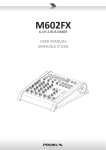

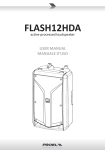
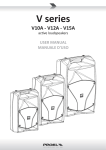

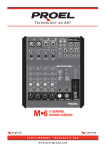
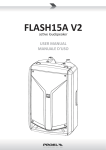
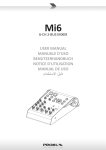
![[ITA] MATRIX Manuale installazione v1-0 lo](http://vs1.manualzilla.com/store/data/006142885_1-10ad66da0d46c3bc6d59dad72c42e536-150x150.png)
![[ITA] MATRIX Manuale installazione v1-0 lo](http://vs1.manualzilla.com/store/data/006147102_1-fa7918564fa6c545bcfb385c99312d88-150x150.png)
